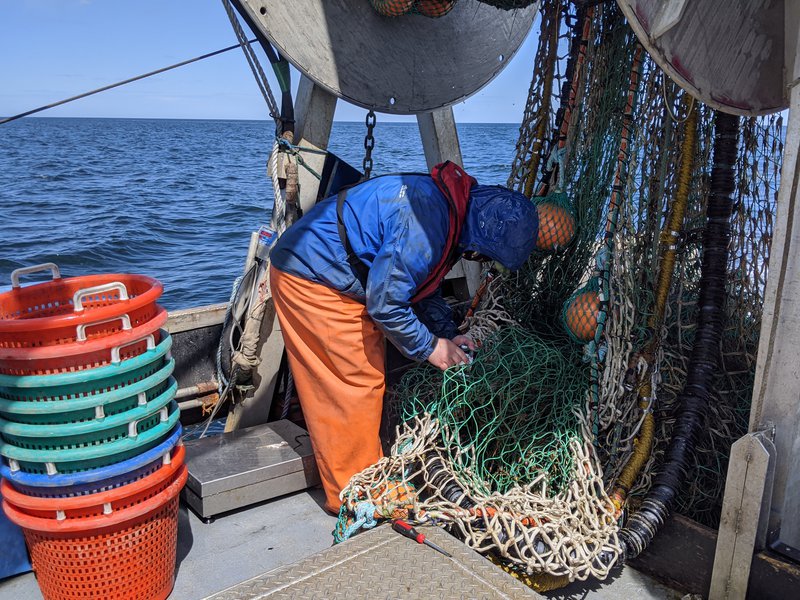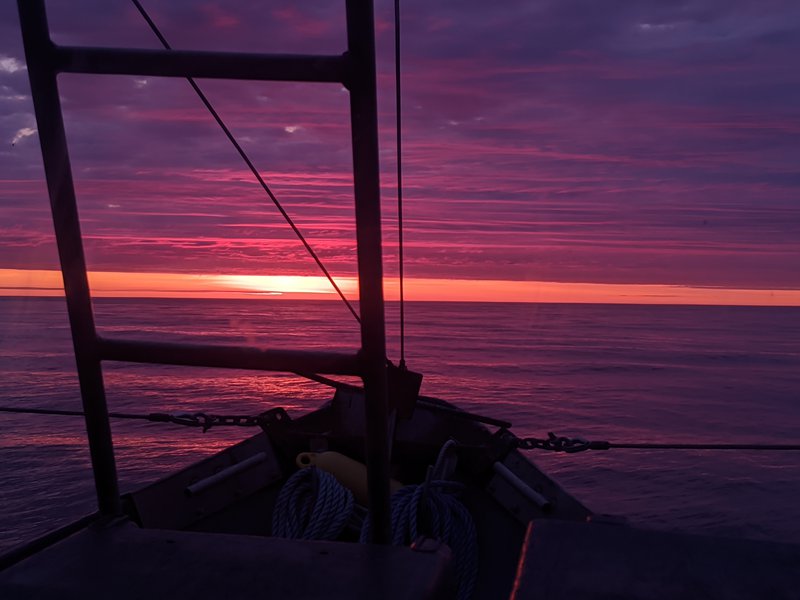Industry Collaboration Fuels New Fishing Technology
Perspectives | Aug 31, 2020
As fisheries and regulations have changed, Captain Jim Ford is one of many fishermen finding ways to adapt. Ford is a long-term collaborator and partner in our efforts to test new technologies that can help fishermen maintain profitability in the face of these changes.

Like most fishermen, Captain Jim Ford is used to the challenge of manual labor and long hours exposed to the elements at sea. But, in the last decade, some new challenges have proven harder to get used to.
A decade ago, the New England groundfish fishery had to reckon with a seismic management shift. With the adoption of Amendment 16 to the Northeast Multispecies (Groundfish) Management Plan, the fishery transitioned from a days-at-sea system which limited the number of total days a fishing vessel could operate on the water, to a quota-based catch share system which limits how many pounds of a certain fish species harvesters can catch.
Last year, members of the GMRI Community team hosted a series of nine port meetings across New England to understand this transition. During these meetings, many fishermen highlighted (as they have for some time now) the problems that stem from unpredictable annual quota fluctuations.
But for fishermen in the Gulf of Maine, who operate in some of the world’s most rapidly warming waters, change is sometimes the only constant. Part of what defines a successful fisherman is the ability to adapt to those changes.
For example, in response to a series of dramatic reductions in cod quotas, Ford teamed up with GMRI and a team of researchers, fishermen, and net builders in 2017 to design and test the Ultra-Low Opening Trawl (ULOT) net — a net meant to reduce cod bycatch.
The New England groundfish fishery consists of 13 species that tend to swim together, rather than separating by species. As a standard trawl net passes through the water, it may capture any of these species. That means a fisherman may be targeting flounders, but still catch cod by accident.
In early tests, the design advantages of the ULOT net helped reduced cod bycatch by 46.8% while also reducing fuel consumption at sea. Those results were heartening, but Ford is still pushing for more — especially with future cuts to cod quotas looming over the industry.
This year they cut the cod quota another 25 percent and we've already been cut 150 percent, so I don't know how many percent you could keep taking away. If they cut it again, people are going to really have to start using some different technology to completely avoid cod.
Captain Jim Ford Fisherman![a bald white man stands in the wheelhouse of his fishing vessel]() Captain Jim Ford Fisherman
Captain Jim Ford Fisherman
To get ahead of further cuts, Ford came up with a modification to the original ULOT net and recently set out on a research expedition to test it out. But how do you design a net that reduces the amount of one species caught without missing out on the fish you do want to catch?
Fish Behavior Inspires Net Change
When designing a specialized net, one factor is crucial to understand: the behavior of the fish you want to catch or avoid. Capitalizing on the initial ULOT design, new insights into the ways cod respond to threats underwater have pushed Ford's most recent modifications to the fore.
The ULOT design takes advantage of behavioral differences between cod and other groundfish. When pursued by a net, cod may swim upward into the water column — away from the net. Other groundfish, including halibut and flounder, stay lower to the seafloor instead, remaining in the net’s path.
Ford’s modification, which he hopes will further influence cod behavior, is a simple mesh netting clipped on to the head rope and the ground rope of the original ULOT net. He reasons that this netting will serve as an additional sensory cue that can alert cod to an incoming trawl net earlier, forcing them to swim upwards to safety sooner.
“The idea that cod rise in response to perceived threats is actually a fairly revolutionary idea, because some earlier research suggested cod stay lower to the seafloor. So, the idea that you could do something on the top of the net that plays to cod behavior was kind of a breakthrough,” said Dr. Mike Pol, a member of the original ULOT design team and a researcher at the Massachusetts Division of Marine Fisheries (MA DMF). “In net design, fish behavior underpins all of it.”
With the new design in place, the team quickly moved to test the impact of the net modifications.


Partners & Pandemic-Proof Fieldwork
As is the case for many research experiments, the process of obtaining the mesh net modification, conducting the experiment, analyzing the results, and writing a report on catch data is expensive. Thankfully, The Nature Conservancy (TNC) supported Ford’s effort by both purchasing the mesh net modification and funding the preliminary tests. This initial effort led to a collaborative project between Ford, GMRI, TNC, and MA DMF to conduct a robust trial of the modification, funded by NOAA’s Bycatch Reduction and Engineering Program.
A global pandemic only made the experiment more challenging to navigate, but in late-May, Ford and a small masked team, including GMRI Fisheries Technical Assistance Program Manager Heather Cronin, GMRI Research Associate Aaron Whitman, and Geoff Smith from TNC, set out to test out the modification and collect catch data.
“Most of us are trying to fish around all the quotas and maximize the profit as much as possible,” Ford said. “That's a big thing that drives me to want to do things like this, to maximize the profits and stay within quotas.”
As Cronin can attest, though, it’s not easy to collect viable data on a small fishing vessel at sea during a pandemic.
“There's only so much space on a fishing boat, but we wore masks and did our best to remain physically distant on deck,“ said Cronin. “It was encouraging to get out there safely with a group of people who are really focused on creating something that could help improve the fishery."
Ford will need to gather more data before determining whether the modification is successful. He's hopeful the mesh netting will work, but he is already thinking up new ways to adapt the newest iteration of the ULOT.


Nets, Cameras, Action!
Net design represents just one collaboration between Ford and GMRI aimed at improving the economic and ecological sustainability of their fishing operations. Concurrently, Ford is also participating in an electronic monitoring (EM) program led by Cronin.
With fishing vessels limited by pounds of fish per year, fishermen are required to monitor and report each and every fish caught, including those discarded at sea. Typically, a third-party human observer will join a vessel to record catch data, but human observers can be both costly and error-prone. On top of that, adding a new (and sometimes inexperienced) person to a fishing vessel is always a safety concern for captains like Ford.
As a participant in Cronin’s EM program, Ford’s fishing vessels are fitted with a system of cameras and computers that capture accurate catch data without the safety risks or additional costs of having a human observer on board. EM has emerged as a potential money-saving option as the government prepares to transfer the responsibility of monitoring costs to fishermen.
This expedition allowed Heather and Jim to operate both systems (the new net and cameras) simultaneously, and both Cronin and Ford realized that the benefits of EM go beyond quota monitoring.
For Cronin, the cameras onboard demonstrated their utility as research tools that made it easier to collect quality data. Perhaps more importantly, convincing other fishermen to adopt new techniques or tools is not always easy, and these onboard cameras also record footage that may demonstrate the benefits of the ULOT to other fishermen.
Ford also hopes EM will bridge the disconnect between the fishermen at sea and the decision-makers onshore who allocate annual quota levels. Fishermen often face quota allocations that don’t reflect what they are seeing at sea, but there may be potential to share on-the-water observations through EM technology.
“It's just a constant, constant battle with quota pricing. One year we're told a species is rebuilding and we're in great shape, and then the next year it's a total collapse and they take all our quota away. You can't make a business plan when you can’t count on anything from year to year,” said Ford. “That's why we need to base more of the quotas on what industry sees, and I think electronic monitoring will help with that. You see in real-time what's really there.”
As we all continue to experience changes to our ecosystems, natural resources, and other important elements of our lives, one thing is certain: we will all need to adapt. Whether we're finding new ways to deal with climate change, fluctuating federal regulations, or even a global pandemic, we can all draw inspiration from the problem-solving ability and determined spirit of Jim Ford and his network of collaborators on this project.

Read Next
-
![Maine-Grown Kelp: Opportunity & Impact]()
Maine-Grown Kelp: Opportunity & Impact
In the United States, the Gulf of Maine is the only region where fresh kelp is produced and sold at scale. We checked in with …
Perspectives
-
![Five Steps To Support Local Seafood]()
Five Steps To Support Local Seafood
Here are five simple steps you can take to support the people and businesses who work so hard to provide us with delicious local seafood.
Perspectives
-
![Climate Center Names First Director]()
Climate Center Names First Director
Dr. Dave Reidmiller joined us in August as director of our new climate center. In his role, Dr. Reidmiller will leverage nearly two decades of …
Tidings
-
![The Merlin: Updates to our New Research Vessel]()
The Merlin: Updates to our New Research Vessel
What began as a harpoon tuna fishing vessel, generously donated to GMRI by David Linney and the Linney family, is now a state of the …
Announcements



